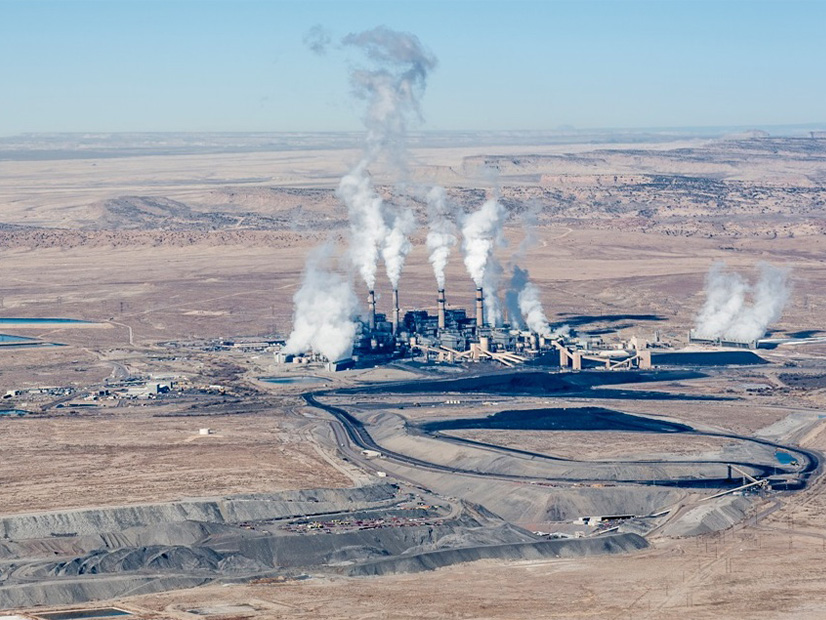Public Service Company of New Mexico (PNM) exhausted every preferred alternative before postponing the retirement of the coal-fired San Juan Generating Station until the end of this summer, a company executive said Wednesday.
The two remaining units at the plant, located in San Juan County, N.M., had been scheduled to close June 30 before the state’s Public Regulation Commission (PRC) in February approved PNM’s request to extend its life by another three months to cover a projected 120-MW shortfall in summer generating capacity.
In 2019, PNM filed with the PRC to abandon its 497-MW stake in the San Juan plant, proposing to replace its output with 650 MW of solar paired with 300 MW of four-hour battery storage. With 45 MW in supplemental demand-side management, the replacement resources were expected to provide 432 MW of effective load-carrying capability. PNM contracted to have all the new resources become operational in time to meet the 2022 summer peak — before San Juan was shuttered.
“This is what we were expecting to have online by about today, and I’ll be frank … none of it is here. All four developers of those solar hybrid projects failed to meet their expected commercial online dates,” Nicholas Phillips, PNM director of resource planning, said Wednesday during a WECC summer readiness virtual workshop.
Phillips said developers have told PNM that supply chain disruptions are the key hurdle to advancing projects, a product of both the COVID-19 pandemic and the U.S. Department of Commerce’s ongoing investigation into whether Chinese companies have been thwarting trade restrictions by dumping solar equipment into the U.S. through firms based in other Asian countries. (See Solar Sector Braces for Tariff Probe Impact.)
Prices for solar have risen by 50 to 100% or more since the onset of the pandemic, while battery costs have jumped by about 30 to 100%, according to Philips. Even prices for simple cycle turbines have increased by 10 to 20%, he noted.
“The supply chain disruptions are hitting all parts of the market, making equipment tough to come by,” he said.
Supply issues extend to the transmission side as well, with generator interconnection timelines being pushed out because of difficulties in securing transformers and other protection-related equipment, in part because of labor shortages, Phillips said.
“We’re facing labor issues here in New Mexico as well, in terms of trying to get enough contractors to actually perform work to construct the interconnection facilities to get generators interconnected on time,” he said.
‘Not Just a Blip’
With the shutdown of San Juan looming in June and no new resources available to replace the facility, PNM — which operates a 2,000-MW peak system — forecasted that it would face a -5.5% reserve margin over the July-September summer peak period.
Phillips said the utility explored multiple options to address the capacity shortfall. It secured a deal to purchase 40 MW from a neighboring utility, won a bid for 150 MW for June and September (but not for the more critical months of July and August) and purchased 85-MW unit-contingent energy from the Four Corners coal plant in New Mexico.
But multiple requests for proposals that PNM issued turned up no viable projects to meet the summer 2022 peak, and a utility review of existing assets for possible capacity expansion determined that none of those upgrades could be completed in time. The utility also found little liquidity in the region’s forward market for electricity.
As a result, PNM decided to keep Unit 4 of San Juan operating through the summer, which will provide 327 MW of capacity and bump the utility’s forecast reserve margin to 17.4% for July-August and 25% for September. The unit will run at full load over the summer period to reduce cycling, Phillips said.
“Given those purchases that we were able to make and the additional capacity that we are getting now from our existing San Juan unit for continuing its operations … we are at a pretty comfortable level,” Phillips said. “You know, I’m a resource planner: I’m probably never comfortable. It’s not where I want it to be; it’s not where I would like to be in the future.”
Beyond this summer, the future looks less certain for PNM. While the utility expects two of its original projects — totaling 350 MW of solar and 170 MW of storage — to be online by early next year, the other two are currently subject to renegotiation. Phillips said PNM has talked with a “number of different developers” to find one that could complete the projects, which it hopes to bring online by summer 2024.
Because New Mexico’s clean energy rules make it impossible to further extend San Juan’s life, PNM will continue to “canvass the market” in search of new clean resources, Phillips said. He thinks the supply chain issues that have delayed the utility’s existing projects are “not just a blip.”
“They’re going to persist for a while.”




